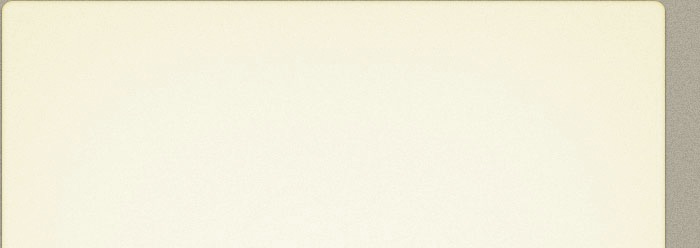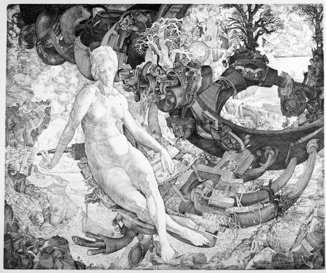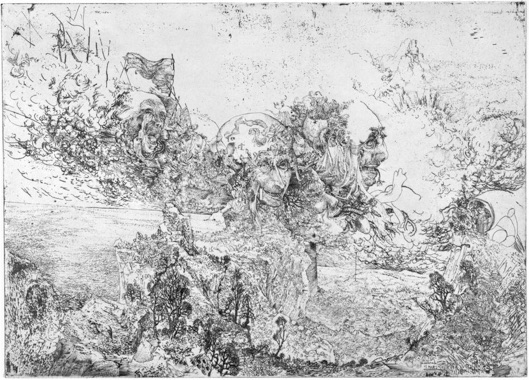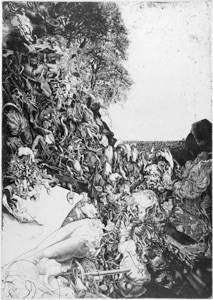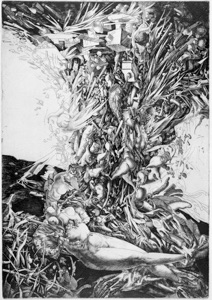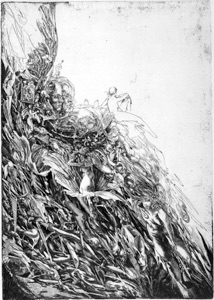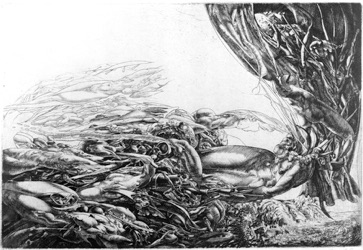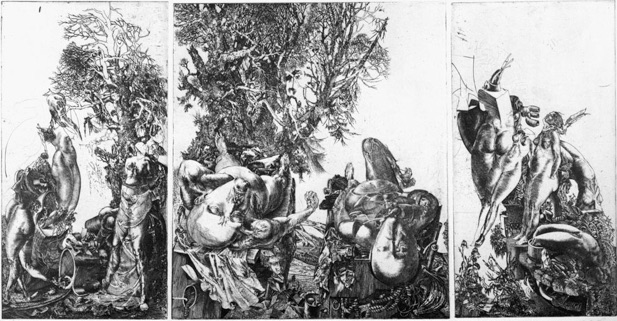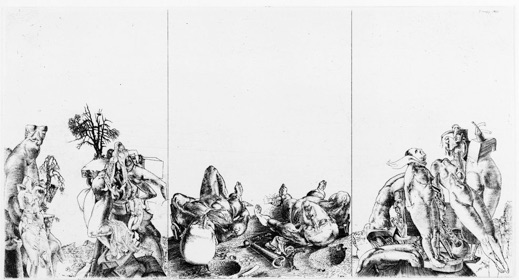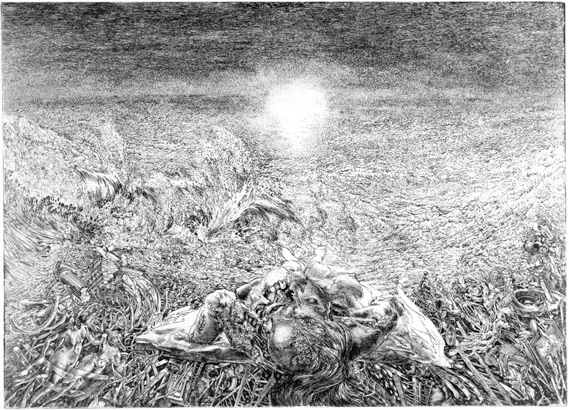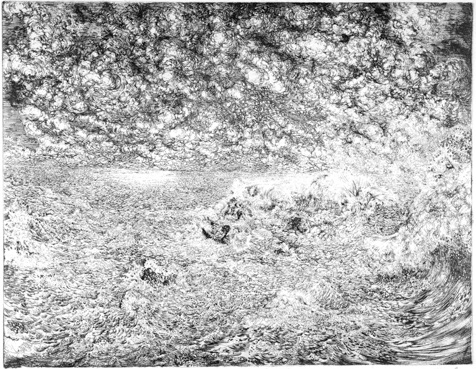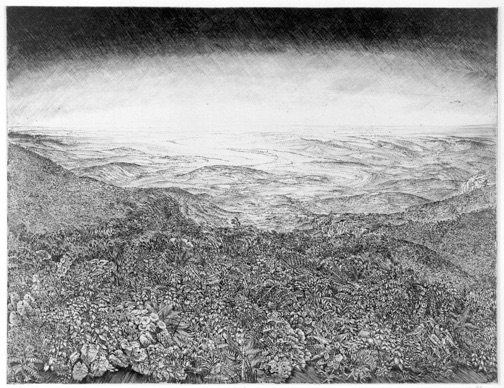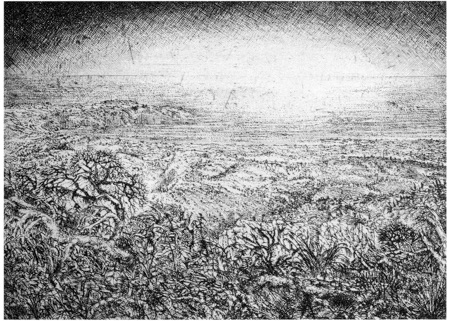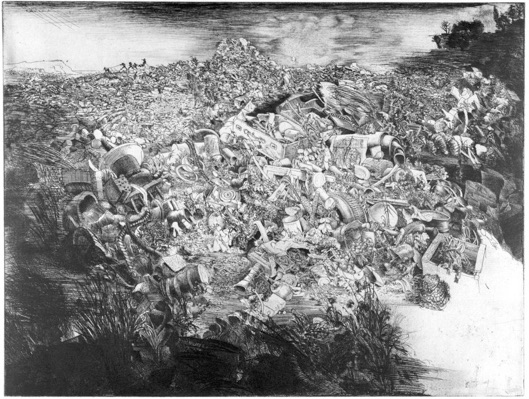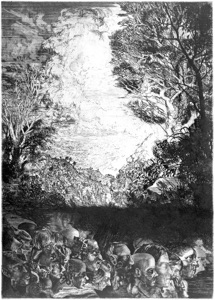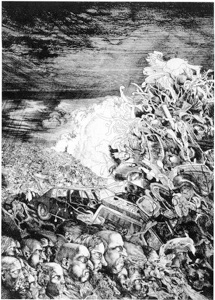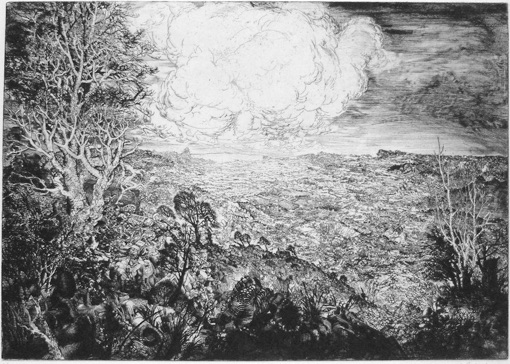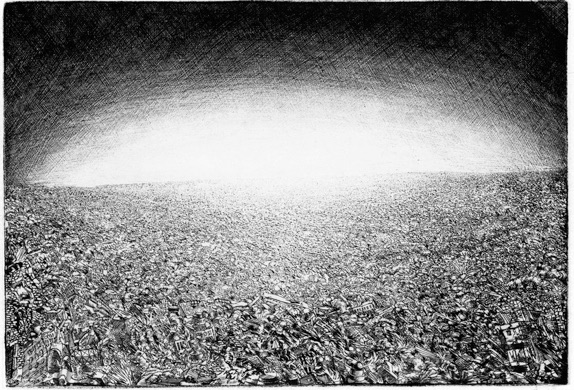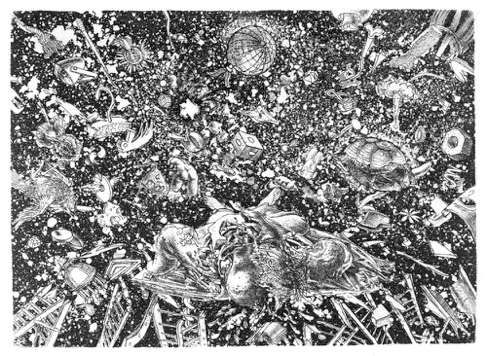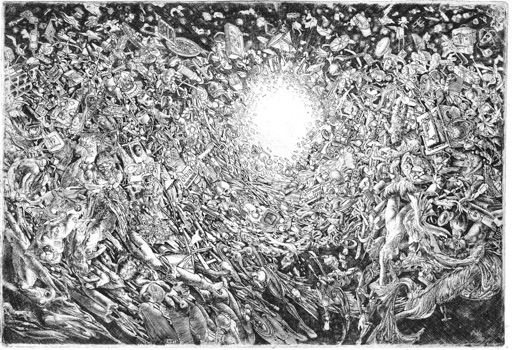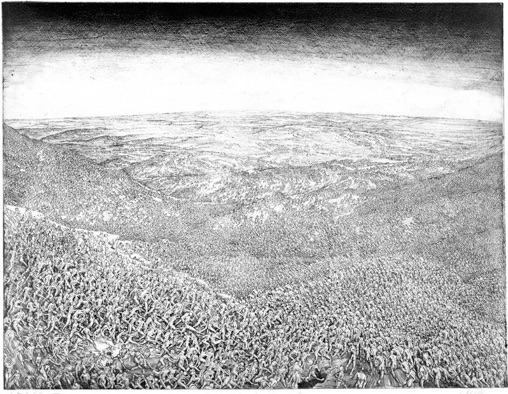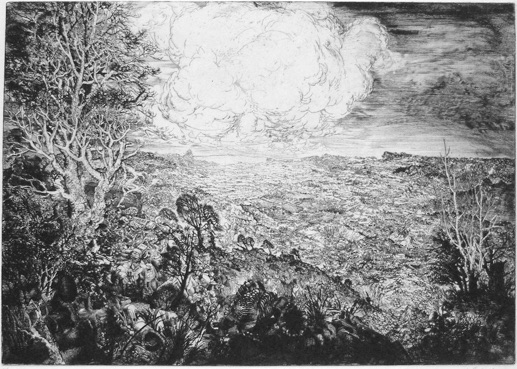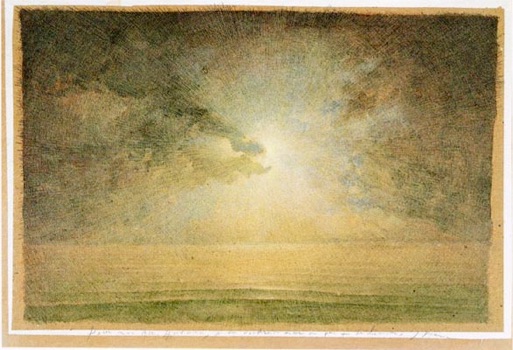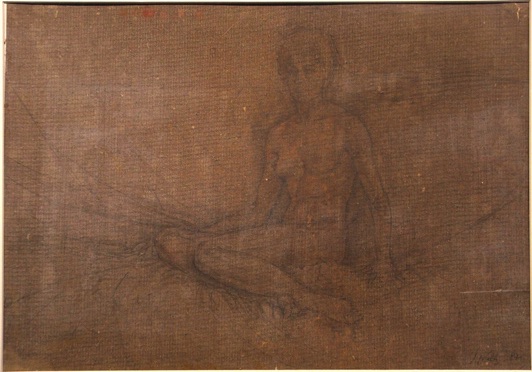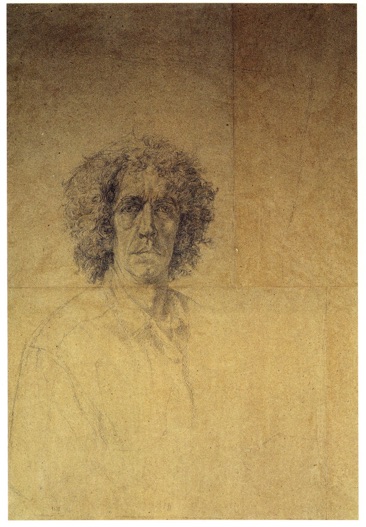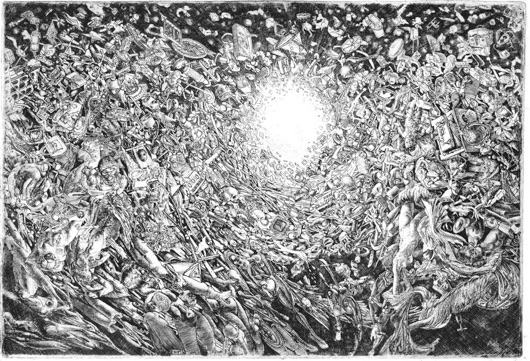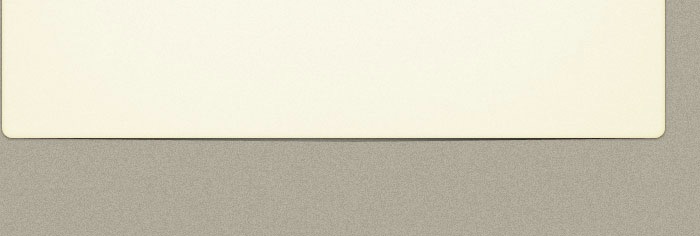adapted from
Ivana Rossi
The etchings of Jean-Pierre Velly
in n° 19 of Grafica , the etching Directory of Italy,
published by Giorgio Mondadori, 1989
translation: Pierre Higonnet
Whatever the secret impact of a “fantastic” art piece may generate onto the viewer, the anxiety, this strange impression of disorientation or loss, these feelings (and more) belong basically to this type of art and of its inner language, a language that Jean-Pierre Velly has employed since the beginning of his career. This artist deserves a special attention and particular consideration due to the total originality of his prints, for their inventiveness and for the unquiet themes they convey, including all the subsidiary implications they carry.
Born in Audierne, Brittany, France in 1943, Velly first studied at the Ecole des beaux-arts of Toulon, and subsequently at the Ecole Nationale Supérieure des beaux-arts of Paris (Fine art Institute, Paris). But at a certain point, he left France and moved to Italy, to Formello, a small medieval town in the Roman countryside.
Before that period however, he had had a taste of the Italian artistic atmosphere because in June 1966, he was awarded the «Premier Grand Prix de Rome» (Rome prize) in etching, and, subsequently he took part, under the direction of Balthus, in the workshops of the l’Académie de France à la Villa Médicis (the French Academy in Rome); he also was awarded the «Grand Prix des envois de Rome», a prize rewarding his considerable efforts in printmaking during the three years stay at Villa Medici.
Since the beginning, Velly dedicated himself entirely to etching, choosing between the different techniques, engraving, hard-ground and drypoint. He was fascinated by the infinite possibilities of this type of expression and curious to investigate the potentials of chiaroscuro. Right from the start, he also chose to work in black and white, disregarding works in color. In his plates, the strokes go from the deepest blacks, vibrating in multiple ranges of grey and opening up in white glimmers, thus creating a mysterious, innermost atmosphere, typical of his art.
At the origin of Jean-Pierre Velly’s imagery, one will easily trace a strong sensitivity to the Northern School, rooted in the fantastic tradition and related to the great artists from the late Middle Ages to the Early Renaissance such as Schongauer, Dürer, Bosch, Altdorfer, Cranach and Peter Bruegel but also including the Dutch landscape artist Hercules Seghers, up to Visionary, Romantic artists such as Rodolphe Bresdin, up to Max Ernst and other German Expressionists.
What characterises on a general basis Velly’s etchings is the Fantastic. It is often expressed through his vision of landscape. The observer’s eye goes astray trying to pursue the endless lines of the horizon, widespread mountainous areas and vegetation mingled with dumps of rubbish and debris. Silhouettes of men and women transfigured by Time, torn bodies, faces haunted by memories and by apocalyptic visions, blend and accumulate with different types of elements. Velly thus unleashes his own fantasies, creating a dreamlike, intensely spiritual space. His landscapes are transfigured by the greatness of Life and Death, the mystery of existence. The forces of Nature merge in a continuous cosmic union which embraces the smallest fragment of the Universe, the tiniest particle of matter. In this regard, one can speak of religiosity, without necessarily linking it to an established faith. Religiosity therefore, as an expression of the limit to human comprehension of the mystery of existence in a blissful contemplation of creation; there might be also a subtle irony that underlines the stupid presumption of the human, assured of his superiority on all other beings, the sole master of life on earth. A warning it seems, to human vanity and certain useless values, that are in fact just transient merriment.
His statement on mankind leaning towards the accumulation of material goods, giving him a social status (rather than a widespread ethical reflection), its selfish, mean vision of life, can be already sensed in a series of engravings of 1964-65, called Grotesques and Illustration pour un conte (1965).
It is not - as we might have thought at first - a controversy on mankind, but an assertion on the precariousness of human life in regard with Time that passes by. Velly believes that the human considers Time as a unit of measure of its own existence and the corruption that eventually applies on all levels of his life, without thinking about the fact that Time could well be a unique and continuous element and that it is man that warps everything.
In the two engravings La Clef des songes (1966) and Vieille femme (1966)
Velly seems to have caught the exact moment of reflection and at the same time the indifference with which the two protagonists watch Time fly. In the first case, a woman still fairly young, unshaken et unconcerned, sits way above on a bunch of rubbish where roots et dead branches of trees are consumed by time; in the second case, an old woman, wrinkled by the years, seems to recall her memories that are now however meaningless.
Another good example of this recurrent theme is illustrated by Mascarade pour un rire jaune, etched in 1967,
where the drama of time fleeing is represented by the ironic and wan faces of these dead and forgotten figures. Their memories seem to emerge from a bustling battle, contrasting with the serene, uncontaminated landscape that centuries have left unchanged.
Time - a focal theme for the artist - is closely related to the transformation and corruption of things. For Velly, everything is subject to corrosion, corrosion due to time, corrosion of places where we live, corrosion of the mind, transformation from good to bad and vice-versa. Nature is a example of continuous transformation. There is no natural law that consolidates a better state of any given element; but the human, due to its own presumption, always seeks to impose a criterion of values.
Fascinated by this unceasing transmutation of various elements, either organic, vegetable or mechanical, Velly underlines this process in a series called Métamorphoses, made in 1970 that includes four etchings.
In Métamorphose III, for instance, the composition seems cut in half diagonally, to enhance on the blank background the endless stream, where different interpenetrating elements of different nature and species are elongated or deformed. A vortex of human figures, animals, objects, vegetable forms mingle in a unique image, whirling memories, recollections of life with no distinction between the present and the future. The sharp strokes of the chisel are mixed with two other techniques, hard-ground and drypoint, creating thus a particular effect of chiaroscuro. Noticeably, etchings by Jean-Pierre Velly are always characterised by the use of a extremely refined technique. The most detailed and precise objects breathe life thanks to the metal point of his chisel, details that populate the space of his plates in a wise balance, as to testify of an antique skill from Flemish origin.
The theme of metamorphosis show through in numerous other works such as Valse lente pour l'Anaon (1967),
Esquisse Triptyque (1967),
N’amassez pas les trésors (1970),
Bodies are mutating (ropes, metallic objects, organic, anthropomorphic and vegetable elements, small images of animals), invigorated by a whole network of veins and arteries.
The metamorphosis of the woman’s body is constant and is repeated in a perpetual renewal of natural elements, climaxing with the horizon in the background, where the blind sun’s light illuminates all, as in an anthem to life.
In fact, the theme of time fleeing and metamorphosis of life are intimately related to the landscape, and should be considered as the main focus of the artist’s “poetry”.
Landscape is the most recurrent theme in Velly’s works, as either the main subject or as the background of his compositions. The artist modifies the landscapes to suit his own concerns, putting into them an emotional strain, full of anxiety and doubt, reflected in the contrast between the minute human dimension and the infinite variety of the world.
Velly’s landscapes stretch out at bird’s eye view, through widespread seascapes which vibrate as the waves reach up to the sky covered with clouds (Le ciel et la mer, 1969 -above)
through endless cliff top covered with grass, flowers and shrubs, (Paysage plante, 1971;
Petit Paysage 1972), here to symbolise the contamination of nature’s forces.
Other works represent visions of piles of rubbish, dumps, smashed cars, gears, ropes, tubes, ordinary objects, witness of our civilisation going astray in the flow of time, leaving behind as a legacy the most insignificant things.
Tas d'ordures, 1969
Senza Rumore I et Senza Rumore II , 1969
Paysage aux autos, 1969
Ville détruite, 1971
To complete this overview, apocalyptic visions and cosmic ordeals appear, where humans and objects intermingle, souvenirs of the past and of the present.
Après, 1971
Enfin, 1973
Un point, c’est tout ,1978
Finally, landscapes in his etchings assume a tragic aspect
Massacre des innocents (1970-1971)
where the endless, pointless race of mankind fuels to the viewer dread and doubt.
The profound and complex consideration on Life which is at the core Velly’s works is appears in every one of his works: for instance, in Enfin
the vertiginous swirl of elements that rotates on itself in outer space, could be a meditation on the mysterious origin of everything;
in Paysage aux autos of 1969, the white glow, the overlapping branches contrast with the frameworks of cars and other machinery ; the panorama is confused in a sequence of chiaroscuri that eventually brings the eye to a more open horizon, to remind man of his presumption and the limit that he may not trespass.
*
Since 1980 circa, Velly has spent less time on printmaking, dedicating himself to other techniques, including drawing, oil, and watercolor. After the series of 1978 watercolors inspired the poetry of Tristan Corbière, he published in 1980 in a book a series called Bestiaire perdu, including his own poetry. In this particular occasion, he has vigorously underlined the pretension of man who elected himself king of the creation, tremendous product of Nature’s evolution, and assume the right to release is wickedness and violence onto certain scorned animals, scorned because considered inferior, like insects, rats, owls, snakes, scorpions, and bats.
In 1984, flowers become the central motif of his watercolors with a series titled Au-delà du temps; these still-lifes hover in the light between warm and cold tones; they are a reflection on the meaning of life. The old paper, previously torned is to be filled with blue bells, honesty, bramble, de bougainvillea and wisteria, bathed in a intimate atmosphere.
The paintings dated between 1985 and 1986 recall the theme of flowers and landscapes : Light becomes the main argument, lighting up the “subject” of the composition in pale, whitish, sometimes moonlit, metallic gleams.
The latest Velly exhibition in Rome that took place in April 1988, featured oils, watercolors and drawings,which subject matters (trees, female nudes, autoportraits, a few landscapes and still lifes) conveyed once more the tragic aspect Romanticism confined in this artist; the works seem to urge man to ponder on the mystery and meaning of Life.
Velly’s artworks are ageless poems, without beginning nor end; they are a communication between Consciousness and the Inconscious, between Life and Death. It is the mark prior the destruction that drags everything into a confused oblivion. In every single work though Silence prevails, a deep silence, amplified by thousands of moments of life confined in every minutely etched object by the fine point of his chisel.
The sensitivity and grandeur of Velly lie in his capacity to uncover the moment between life and death, to capture in a image everything that Time changes, even the most insignificant particle of matter, likewise mankind therefore, which is only but a minuscule dot in the infinite horizon of the universe.
Ivana Rossi
The etchings of Jean-Pierre Velly,
in the n. 19 issue of Grafica , the etching diary of Italy,
published by Giorgio Mondadori , 1989
*********************
Marie-Luise Sciò wrote in «International Daily News» 1978:
“Stendhal and Corbière meet throught the artfull hands of Velly. The 19th century French writer Stendhal (actually a pseudonym for Marie-Henry Beyle), Breton’s poet of the same period, Corbière, and Velly are linked by heritage, love and philosophy.
All are Frenchman. All have been infatuated by the romantic italian skies. All are logicians and poets simultaneously. All have questioned life after death. All have observed man and nature and made precise psycological observations.
A puntctilious technique won Velly the coveted Grand Prix de Rome, and it is to be seen in 24 watercolors which paint the poet Corbière «Rondels Pour Après». The six poems of the poet whose life ended at 30 in 1875 are dialogues of the self. Short, artistically fluid, but with a morbid base, there is a coupling of the heroic with the drammaic. Velly is akin in spint, and picks up on Corbière’s conception of life after life.
… «I prefer watercolors to the technique of etching, I fell more free in my renderings» said Velly on the first day of the show «but any works retains my training as an etcher”.
This obvious in the composition of ecru in which he depicts the dead poet as booking into a coffin, it is executed in fine lines of a rainbow. The poet done in pencil lies over a series of figures who move out from a central line. In a rendering of a page from a childs notebook, the soft image of a boy is reflected. An ink spot on the upper right of the page of the book is, as Velly said, «like a star that brings the poet to the rising star through a series of swirling ink blotched». He goes on: The observer’s eyes travels to the spot of pale red ink that is spilled on a portion of a notebook from an obviously older student, as the squares are smaller. Then, from there, ink spills softly in gray to bring you back to the poet. The draw drops that faintly frame the notepaper relate life to nature, and back».
In all of the 24 works, Velly shows his pinpoint clarity, and his ironist sentimentalist nature. An artist with exceptional ability; he has done an exquisite series.
(cfr. Marie-Luise Sciò, A french artist with acute eye and a master’s touch,
in «International Daily News», Roma, 5-6 marzo 1978).
“Stendhal and Corbière meet through the artful hands of Velly. The 19th century French writer Stendhal (actually a pseudonym for Marie-Henry Beyle), Breton’s poet of the same period, Corbière, and Velly are linked by heritage, love and philosophy.
All are Frenchman. All have been infatuated by the romantic italian skies. All are logicians and poets simultaneously. All have questioned life after death. All have observed man and nature and made precise psycological observations.
A punctilious technique won Velly the coveted Grand Prix de Rome, and it is to be seen in 24 watercolors which paint the poet Corbière «Rondels Pour Après». The six poems of the poet whose life ended at 30 in 1875 are dialogues of the self. Short, artistically fluid, but with a morbid base, there is a coupling of the heroic with the dramatic. Velly is akin in spint, and picks up on Corbière’s conception of life after life.
… «I prefer watercolors to the technique of etching, I fell more free in my renderings» said Velly on the first day of the show «but any works retains my training as an etcher”.
This is obvious in the composition of ecru in which he depicts the dead poet as booking into a coffin, it is executed in fine lines of a rainbow. The poet done in pencil lies over a series of figures who move out from a central line. In a rendering of a page from a childs notebook, the soft image of a boy is reflected. An ink spot on the upper right of the page of the book is, as Velly said, «like a star that brings the poet to the rising star through a series of swirling ink blotched». He goes on: The observer’s eyes travels to the spot of pale red ink that is spilled on a portion of a notebook from an obviously older student, as the squares are smaller. Then, from there, ink spills softly in gray to bring you back to the poet. The draw drops that faintly frame the notepaper relate life to nature, and back».
In all of the 24 works, Velly shows his pinpoint clarity, and his ironist sentimentalist nature. An artist with exceptional ability; he has done an exquisite series.
(cfr. Marie-Luise Sciò, A french artist with acute eye and a master’s touch, in «International Daily News», Roma, 5-6 marzo 1978).
